
September 8 (September 21)
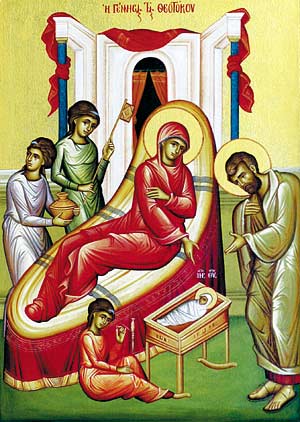
The Feast of the Nativity of Our Most Holy Lady, the Theotokos and Ever-Virgin Mary is celebrated on September 8 each year. The Feast commemorates the birth of the Mother of Jesus Christ, our Lord.
Background
The birth and early life of the Virgin Mary is not recorded in the Gospels or other books of the New Testament, however this information can be found in a work dating from the second century known as the Book of James or Protevangelion.
According to the story found in this book, Mary's parents, Joachim and Anna, were childless for many years. They remained faithful to God, but their prayers for a child were unanswered. One day, when Joachim came to the temple to make an offering, he was turned away by the High Priest who chastised him for his lack of children. To hide his shame, Joachim retreated to the hill country to live among the shepherds and their flocks.
As Joachim was praying, his wife Anna was praying at the same time at their house in Jerusalem. An angel appeared to both of them and announced that Anna would have a child whose name would be known throughout the world. Anna promised to offer her child as a gift to the Lord. Joachim returned home, and in due time Anna bore a daughter, Mary.
Icon of the Feast
The icon of the Nativity of the Thetokos presents to us the central figures of Saints Joachim (2) and Anna (1), Mary's parents, and the Mother of our Lord as an infant. Saint Anna is in the middle of the icon with her right hand extended toward her daughter (3). Likewise, Saint Joachim, Mary's father, is gazing upon the young child with his right hand extended toward her (3). Anna is surrounded by attendants who have assisted with the birth.
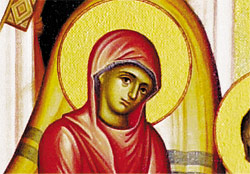
1. Saint Anna, Mother of the Theotokos, offered her child as a gift to the Lord.
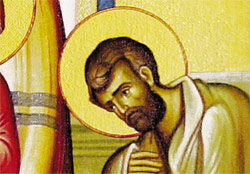
2. Saint Joachim, Father of the Theotokos.
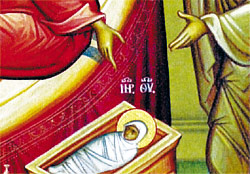
The icon directs attention to Mary as the central figure in this feast (4). It also acknowledges the joy that was felt by Joachim and Anna as new parents with a child received through a promise from God. The liturgical texts of the feast acknowledge this joy and confirm the special role of Mary as the Mother of the Incarnate God, Jesus Christ. In this event, another step is made in sacred history in preparation for the entrance of Christ into the world.
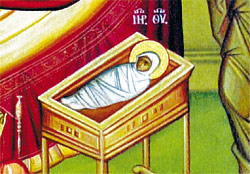
The icon and the feast also acknowledge a transition from barrenness to life. This was but another foreshadowing of what would be offered through Christ, the transformation from death to eternal life.
Celebration of the Feast of the Nativity of the Theotokos
The Feast of the Nativity of the Theotokos is celebrated with the Divine Liturgy of Saint John Chrysostom which is conducted on the morning of the Feast and preceded by a Matins (Orthros) service. A Great Vespers is conducted on the evening before the day of the Feast. Scripture readings for the Feast are the following: At Vespers: Genesis 28:10-17; Ezekiel 43:27—44:4; Proverbs 9:1-11. At the Matins: Luke 1:39-49, 56. At the Divine Liturgy: Philippians 2:5-11; Luke 10:38-42; 11:27-28.
---------
ESPAÑOL:
8 de septiembre (21 de Septiembre)
 Introducción
Introducción
La fiesta de la Natividad de Nuestra Santísima Señora, Theotokos y Siempre Virgen María se celebra el 8 de septiembre de cada año. La fiesta conmemora el nacimiento de la Madre de Jesucristo, nuestro Señor.
El nacimiento y la vida temprana de la Virgen María no están registrados en los Evangelios u otros libros del Nuevo Testamento, sin embargo, esta información se puede encontrar en una obra que data del siglo II conocida como el Libro de Santiago o Proto-evangelio.
Según la historia que se encuentra en este libro, los padres de María, Joaquín y Ana, no tuvieron hijos durante muchos años. Permanecieron fieles a Dios, pero sus oraciones por un niño no fueron respondidas. Un día, cuando Joaquín llegó al templo para hacer una ofrenda, el Sumo Sacerdote lo rechazó y lo reprendió por su falta de hijos. Para ocultar su vergüenza, Joaquín se retiró a la región montañosa para vivir entre los pastores y sus rebaños.
Mientras Joaquín rezaba, su esposa Ana rezaba al mismo tiempo en su casa
en Jerusalén. Un ángel se les apareció a ambos y anunció que Ana
tendría un hijo cuyo nombre se conocería en todo el mundo. Anna prometió
ofrecerle a su hijo un regalo al Señor. Joaquín regresó a casa y, a su
debido tiempo, Anna dio a luz a una hija, María.
Ícono de la fiesta
El ícono de la Natividad de Thetokos nos presenta las figuras centrales de los santos Joaquín (2) y Ana (1), los padres de María y la Madre de nuestro Señor cuando era un bebé. Santa Ana está en el medio del icono con su mano derecha extendida hacia su hija (3). Del mismo modo, San Joaquín, el padre de María, mira al niño con la mano derecha extendida hacia ella (3). Anna está rodeada de asistentes que han ayudado con el parto.


 3. Tanto Santa Ana como San Joaquín, que no tuvieron hijos durante muchos años, presentan a su hija.
3. Tanto Santa Ana como San Joaquín, que no tuvieron hijos durante muchos años, presentan a su hija.
El ícono dirige la atención a María como la figura central en esta fiesta (4). También reconoce la alegría que sintieron Joaquín y Ana cuando los nuevos padres con un hijo recibieron a través de una promesa de Dios. Los textos litúrgicos de la fiesta reconocen esta alegría y confirman el papel especial de María como la Madre del Dios Encarnado, Jesucristo. En este caso, se da otro paso en la historia sagrada en preparación para la entrada d
e Cristo en el mundo.
 4. La figura central de la fiesta, Theotokos y Siempre Virgen María (detalle).
4. La figura central de la fiesta, Theotokos y Siempre Virgen María (detalle).
El ícono y la fiesta también reconocen una transición de la esterilidad a la vida. Esto no era más que un presagio de lo que se ofrecería a través de Cristo, la transformación de la muerte a la vida eterna.
La celebración de la Fiesta de la Natividad del Theotokos. La Fiesta de la Natividad de Theotokos se celebra con la Divina Liturgia de San Juan Crisóstomo, que se lleva a cabo en la mañana de la Fiesta y precedida por un servicio de Matins (Orthros). La Gran Víspera se lleva a cabo la noche antes del día de la Fiesta. Las lecturas de las Escrituras para la fiesta son las siguientes: en las vísperas: Génesis 28: 10-17; Ezequiel 43: 27—44: 4; Proverbios 9: 1-11. En los maitines: Lucas 1: 39-49, 56. En la Divina Liturgia: Filipenses 2: 5-11; Lucas 10: 38-42; 11: 27-28.

La fiesta de la Natividad de Nuestra Santísima Señora, Theotokos y Siempre Virgen María se celebra el 8 de septiembre de cada año. La fiesta conmemora el nacimiento de la Madre de Jesucristo, nuestro Señor.
El nacimiento y la vida temprana de la Virgen María no están registrados en los Evangelios u otros libros del Nuevo Testamento, sin embargo, esta información se puede encontrar en una obra que data del siglo II conocida como el Libro de Santiago o Proto-evangelio.
Según la historia que se encuentra en este libro, los padres de María, Joaquín y Ana, no tuvieron hijos durante muchos años. Permanecieron fieles a Dios, pero sus oraciones por un niño no fueron respondidas. Un día, cuando Joaquín llegó al templo para hacer una ofrenda, el Sumo Sacerdote lo rechazó y lo reprendió por su falta de hijos. Para ocultar su vergüenza, Joaquín se retiró a la región montañosa para vivir entre los pastores y sus rebaños.
Ícono de la fiesta
El ícono de la Natividad de Thetokos nos presenta las figuras centrales de los santos Joaquín (2) y Ana (1), los padres de María y la Madre de nuestro Señor cuando era un bebé. Santa Ana está en el medio del icono con su mano derecha extendida hacia su hija (3). Del mismo modo, San Joaquín, el padre de María, mira al niño con la mano derecha extendida hacia ella (3). Anna está rodeada de asistentes que han ayudado con el parto.

1. Santa Ana, Madre de la Theotokos, ofrece su hija como una ofrenda al Señor.

2. San Joaquín, Padre de la Theotokos.

El ícono dirige la atención a María como la figura central en esta fiesta (4). También reconoce la alegría que sintieron Joaquín y Ana cuando los nuevos padres con un hijo recibieron a través de una promesa de Dios. Los textos litúrgicos de la fiesta reconocen esta alegría y confirman el papel especial de María como la Madre del Dios Encarnado, Jesucristo. En este caso, se da otro paso en la historia sagrada en preparación para la entrada d
e Cristo en el mundo.

El ícono y la fiesta también reconocen una transición de la esterilidad a la vida. Esto no era más que un presagio de lo que se ofrecería a través de Cristo, la transformación de la muerte a la vida eterna.
La celebración de la Fiesta de la Natividad del Theotokos. La Fiesta de la Natividad de Theotokos se celebra con la Divina Liturgia de San Juan Crisóstomo, que se lleva a cabo en la mañana de la Fiesta y precedida por un servicio de Matins (Orthros). La Gran Víspera se lleva a cabo la noche antes del día de la Fiesta. Las lecturas de las Escrituras para la fiesta son las siguientes: en las vísperas: Génesis 28: 10-17; Ezequiel 43: 27—44: 4; Proverbios 9: 1-11. En los maitines: Lucas 1: 39-49, 56. En la Divina Liturgia: Filipenses 2: 5-11; Lucas 10: 38-42; 11: 27-28.
+++





No hay comentarios:
Publicar un comentario
Nota: solo los miembros de este blog pueden publicar comentarios.